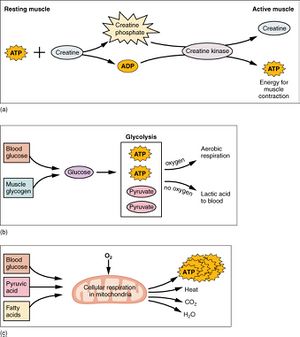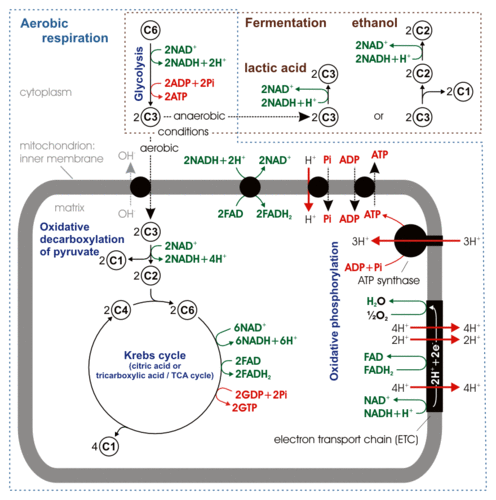Cellular respiration

Source: Betts, JG; Young, KA; Wise, JA; Johnson, E; Poe, B; Kruse, DH; Korol, O; Johnson, JE; Womble, M; DeSaix, P (April 25, 2013). "10.3 Muscle Fiber Contraction and Relaxation". Anatomy and Physiology. OpenStax. Houston, Texas.[1]
Cellular respiration is the set of metabolic reactions and processes that take place in the cells of organisms in order to convert biochemical energy from food into energy that can be used to carry out life processes.
Process[edit | edit source]
Cellular respiration occurs within the cells mitochondria and cytoplasm (jelly-like substance that fills a cell). The general chemical formula for cellular respiration is glucose + oxygen --> carbon dioxide + water + energy.[1][2] For the human body, usable energy comes in the form of a molecule called adenosine triphosphate (ATP). Cellular respiration is then the way in which the cells of the human body turn nutrients into ATP; this process can be broken down into four core steps:
- Glycolysis: the first step of cellular respiration is the breakdown of glucose into energy that the body can utilize.
- Oxidative decarboxylation of pyruvate: this step is done by an enzyme called the Pyruvate Dehydrogenase Complex (PDC).
- Citric acid cycle (Krebs cycle or TCA cycle): is a series of chemical reactions that take stored energy (proteins, fats, carbs) and convert them into ATP.
- Oxidative phosphorylation: the last step of cellular respiration uses a combination of several enzymes and oxygen to create a large quantity of ATP from the energy-dense molecules that were broken down in the previous steps.

Anaerobic Respiration[edit | edit source]
Organisms can also perform respiration without oxygen in a process called anaerobic respiration. In human cells, anaerobic respiration occurs through a process known as fermentation. If a cell does not have adequate oxygen to undergo cellular respiration then fermentation allows for glycolysis to continue to run. Anaerobic respiration is far less efficient at producing ATP than aerobic respiration.[2]
Myalgic Encephalomyelitis and cellular respiration[edit | edit source]
Patients with myalgic encephalomyelitis (ME) have been observed to have an overall lower maximal cellular respiration capacity than control groups.[3] This would mean that a cell would be unable to keep up with its energy needs. Some studies have observed decreased production of ATP and other metabolic intermediates in patients with ME.[4][5]
See also[edit | edit source]
- Citric acid cycle
- Ion transportation (electron transport chain)
- Glycolysis
- Mitochondrion
Learn more[edit | edit source]
- Wikipedia - Cellular respiration
- Cellular Respiration by Bozeman Science
- ATP & Respiration: Crash Course Biology
- Introduction to cellular respiration | Cellular respiration | Biology | Khan Academy
References[edit | edit source]
- ↑ 1.0 1.1 Betts, JG; Young, KA; Wise, JA; Johnson, E; Poe, B; Kruse, DH; Korol, O; Johnson, JE; Womble, M; DeSaix, P (April 25, 2013). "10.3 Muscle Fiber Contraction and Relaxation". Anatomy and Physiology. OpenStax. Houston, Texas. Retrieved January 28, 2022.
- ↑ 2.0 2.1 "Cellular respiration review". Khan Academy. Retrieved August 13, 2018.
- ↑ Tomas, Cara; Brown, Audrey; Strassheim, Victoria; Elson, Joanna; Newton, Julia; Manning, Philip (October 24, 2017). "Cellular bioenergetics is impaired in patients with chronic fatigue syndrome". PLOS ONE. 12 (10): e0186802. doi:10.1371/journal.pone.0186802. ISSN 1932-6203. PMID 29065167.
- ↑ Nguyen, Thao (2017). "Reduced glycolytic reserve in isolated natural killer cells from Myalgic encephalomyelitis/chronic fatigue syndrome patients: A preliminary investigation" (PDF). APJAI.
- ↑ Naviaux, Robert K.; Naviaux, Jane C.; Li, Kefeng; Bright, A. Taylor; Alaynick, William A.; Wang, Lin; Baxter, Asha; Nathan, Neil; Anderson, Wayne (September 13, 2016). "Metabolic features of chronic fatigue syndrome". Proceedings of the National Academy of Sciences of the United States of America. 113 (37): E5472–5480. doi:10.1073/pnas.1607571113. ISSN 1091-6490. PMC 5027464. PMID 27573827.

